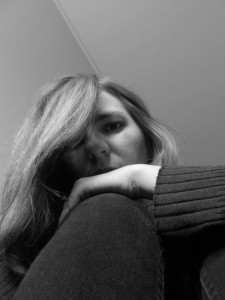She currently lives somewhere between Portland, Austin, Vancouver, and Montreal. You can learn more at http://alexcrenwick.com
Is there a literary heroine on whom you imprinted as a child? A first love, a person you wanted to become as an adult, a heroic girl or woman you pretended to be on the playground at recess? Who was she?
My initial response to this is, Spock. I can think only of Spock as a fictitious character I imprinted on as a child. But he’s no heroine, and of course there were literary ones, back when I was sevenish, eightish. Since my favorite book Watership Down was particularly dude-ly (and all rabbit-ly) I’ll have to go with Scott O’Dell’sIsland of the Blue Dolphins Karana, who lived alone on an island nearly her entire life. Meg from Madeleine L’Engle’s A Wrinkle in Time would be a distant runner up.
Karana and Meg (Spock, too, actually) were all huge for me, too! Can you remember what it was these characters did or what qualities they had that captured your affections and your imagination so strongly?
Well, O’Dell’s heroine is based on Juana Maria, a Nicoleño woman left for 18 years as the lone inhabitant of San Nicolas Island off the California coast before finally being discovered in 1853. My father’s from Grenada in the West Indies, so I felt kinship for an island story (though one set off a distant coast). And I’d always rankled at the narrow Disneyfied blonde/blue-eyed version of feminine beauty. I adored a protagonista not cast in that mould, and identified far more with her than with, say, Cinderella and other dewy ladies. Of course, it was her unflagging resourcefulness and ability to survive by herself, to reason, to make do, to figure things out and take charge of her own destiny that I found so enthralling.
Meg was resourceful too, and daughter-saving-father was a nice fresh take on sons being the stars of what felt like every other written story in the universe, starting with the Bible(?). L’Engle herself suggested the reason “forty-odd” publishers passed on A Wrinkle in Time (her agent sent it back to her after 26 rejections) was that it had a female protagonist in a science fiction setting. It has now been continuously in print since first publication (in 1963), so maybe that’s useful to remember for those of us who identify as going against the grain.
How do Meg and Karana compare to the female characters in your work? Could they be listed among your characters’ literary ancestors?
Oh yes! Definitely. My fascination with writing frontier fiction in general — whether space colony SF, Paleolithic fantasy, or weird-west historical — has its roots in understanding how people might tackle certain problems in extreme circumstances and with limited resources. I guess at heart I’m really a hypothetical-realities anthropologist.
_______
About this post: The Heroine Question is my name for a series of short interviews with female writers about their favorite characters and literary influences. Clicking the link will take you to all the other interviews, with awesome people like Charlene Challenger, Gemma Files, Caitlin Sweet, and Karen Miller.
Also about this post: As I have mentioned, writer Alex Bledsoe recently asked about my use of the gendered word, heroine, in this series. I could have gone with hero, true, or “female heroes” since I was looking for women authors’ female influences. To be honest, my initial inspiration came from my ever-mature desire to make tacky-sounding drug jokes: Gemma Files on Heroin! Oops! Heroine! That kind of thing.
Kelly Robson goes after the Heroines
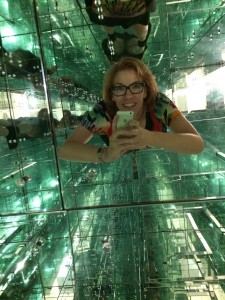 Kelly Robson’s first fiction publications appeared this year in Clarkesworld, Tor.com, Asimov’s, and the anthology New Canadian Noir
Kelly Robson’s first fiction publications appeared this year in Clarkesworld, Tor.com, Asimov’s, and the anthology New Canadian Noir. She spent four years living a weird alternate life as the wine and spirits columnist for Canada’s largest women’s magazine. She’s @kellyoyo on Twitter, and her website is at http://kellyrobson.com/.
I asked her the same questions I put to the rest of the lovely folk who agreed to this run of interviews.
Is there a literary heroine on whom you imprinted as a child? A first love, a person you wanted to become as an adult, a heroic girl or woman you pretended to be on the playground at recess? Who was she?
Nancy Drew, Nancy Drew, Nancy Drew.
I’m sorry, is there anyone else?
Can you remember what it was she did or what qualities she had that captured your affections and your imagination so strongly?
I am blessed/cursed with vivid memories of my childhood, so yes, I sure can remember.
At the age of seven I had no real books, just a few picture books I’d long grown out of. I was a precocious reader but my parents were too caught up with the implosion of their marriage to realize I was starving for reading material.
Mom did occasionally take me to the library but she kept me in the little kids section. I vividly remember bringing stacks of picture books home, burning through them in 20 minutes, and then having nothing satisfying to read.
At some point my Dad and I went into the city – probably to take to the ophthalmologist – and we stayed with my Auntie Amy. I found three Nancy Drew books in her basement rec room. They were The Secret of Shadow Ranch, The Mystery of the 99 Steps
, and The Secret of the Old Clock
.
I started with The Secret of Shadow Ranch. It was a transcendent experience — I fell into it like a hallucinogen. In this book, Nancy is knitting a sweater for Ned. I didn’t know who Ned was, so I imagined he was a kid my age, because then he and I could be friends and that would get me access to Nancy.
Auntie Amy let me take the books home. A million thanks to wonderful aunties! Mom thought Nancy Drew was too old for me (my mom was always invested in keeping me young). Dad never liked to see me reading. I don’t think they ever took books away once I got my hands on them, but they never helped me get any, either. To this day, access to books remains one of my hot button issues.
I could go on, but we were talking about Nancy.
She’s the perfect wish-fulfillment heroine: Not an adult but certainly not a kid. Completely independent emotionally, intellectually, financially, socially, and physically. Nothing is denied her. She can go anywhere, do anything. For me, Nancy was a drug.
How does she compare to the female characters in your work? Is she their literary ancestor? Do they rebel against all she stands for? What might your creations owe her?
Nancy isn’t in anything I’ve written so far, but she does figure into some work I have planned, about characters who’ve been in my head a long while. The less said about them now, the better.
I’m interested in characters who, like Nancy Drew, have everything. What can and can’t they do with that power and privilege? How far will it take them? What barriers can’t be crossed?
I’m not interested in the person who comes up from nothing to achieve much. I’m interested in the person who has it all and finds out how little it does for them.
How do you feel about the word heroine? In these posts, I am specifically looking for female authors’ female influences, whether they’re other writers or Anne of Green Gables. Does the word heroine have a purpose that isn’t served by equally well by hero?
The term hero is no longer clearly gendered the way prince and princess are. It doesn’t require alteration the way fireman and chairman do. Hero is often a gender neutral term, much like actor.
If you asked me about my favourite hero, would probably have interpreted it as gender neutral and (being who I am) I’d probably have assumed you meant superhero. But since you asked about my favourite heroine, I understood your meaning completely.
I think heroine is a useful word that drills down to a specific meaning without contortions. Let’s not get rid of useful words.
_________________________
About this post: The Heroine Question is my name for a series of short interviews with female writers about their favorite characters and literary influences. Clicking the link will take you to all the other interviews, with awesome people like Charlene Challenger, Gemma Files, Caitlin Sweet, and Jessica Reisman.
Also about this post: As I have mentioned, writer Alex Bledsoe recently asked about my use of the gendered word, heroine, in this series. I could have gone with hero, true, or “female heroes” since I was looking for women authors’ female influences. To be honest, my initial inspiration came from my ever-mature desire to make tacky-sounding drug jokes: Gemma Files on Heroin! Oops! Heroine! That kind of thing.
I hope to get up a post that takes the answer further than “I pun, therefore I am.” And I have folded a question about this word into the later interviews; you can see Kelly’s answer here.
Heroine Roundup, Yee Haw!
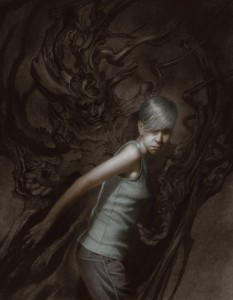 Now that we have more than a dozen Heroine Question interviews in the can, I feel as though an index would be a nice thing to have. If you prefer to simply browse the most recent interviews, they are here for the squeezing. If not, I present the following list of authors, with interview links and a link to one of their books:
Now that we have more than a dozen Heroine Question interviews in the can, I feel as though an index would be a nice thing to have. If you prefer to simply browse the most recent interviews, they are here for the squeezing. If not, I present the following list of authors, with interview links and a link to one of their books:
- Ada Hoffman (Monsters in My Mind)
- Kari Maaren (Weave a Circle Round)
- S.B. Divya (Runtime)
- Karina Sumner-Smith (Towers Fall)
- J. Kathleen Cheney (Dreaming Death)
- Linda Nagata (The Red: First Light)
- Kay Kenyon (Bright of the Sky)
- Louise Marley (The Child Goddess
)
- Juliet McKenna (Aldabreshin Compass Series)
- Brit McGinnis (Smugglers: Maskheads Trilogy
)
- Leah Bobet ( An Inheritance of Ashes
)
- Loren Rhoads (The Dangerous Type)
- Alex Bledsoe (Long Black Curl)
- Marie Brennan ( A Natural History of Dragons: A Memoir by Lady Trent
)
- Alma Alexander (Changer of Days
)
- A.C. Wise (The Ultra Fabulous Glitter Squadron Saves the World Again.)
- Alexandra Renwick (Push of the Sky)
- Kelly Robson, (Waters of Versailles
)
- Tina Connolly (The Ironskin
trilogy).
- Karen Miller (The Falcon Throne
).
- Charlene Challenger (The Voices in Between).
- Jessica Reisman (The Z Radiant
).
- Caitlin Sweet (The Flame in the Maze
).
- Gemma Files (Experimental Film
).
- Jane Lindskold (Artemis Invaded).
- Martha Wells (
Stories of the Raksura: Volume Two
)
The first time I did an interview series on my blog, I asked long, complicated questions. Though the Journeys series–which is about how established SF writers like Jack Dann and Walter Jon Williams got to that point–is really interesting, the essays are lengthy. I like a good chewy read as much as the next human, and I’m a little appalled by the tl;dr phenomenon. Still, after I’d done a blog tour or two, I felt a little as though the incredibly long interview was an imposition on my guests.
So this series is meant to keep it simple. Initially, I’ve been asking three things:
- Is there a literary heroine on whom you imprinted as a child? A first love, a person you wanted to become as an adult, a heroic girl or woman you pretended to be on the playground at recess?
- Can you remember what it was she did or what qualities she had that captured your affections and your imagination so strongly?
- How does she compare to the female characters in your work? Is she their literary ancestor? Do they rebel against all she stands for? What might your creations owe her?
- How do you feel about the word heroine? In these posts, I am specifically looking for female authors’ female influences, whether those women they looked up to were other writers or Anne of Green Gables. Does the word heroine have a purpose that isn’t served by equally well by hero?
The idea is to give the interviewee the option to keep it short and sweet, if they choose–to shoot me three quick answers and a biography/book cover, and to hopefully give us all something to think about in the process.
An interview with Thieftaker Chronicles author David B. Coe @davidbcoe
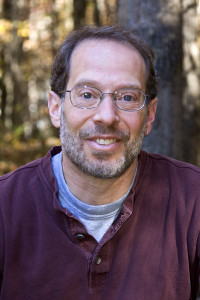 David B. Coe/D.B. Jackson is the award-winning author of eighteen fantasy novels. Under the name D.B. Jackson, he writes the Thieftaker Chronicles, a historical urban fantasy from Tor Books that includes Thieftaker
David B. Coe/D.B. Jackson is the award-winning author of eighteen fantasy novels. Under the name D.B. Jackson, he writes the Thieftaker Chronicles, a historical urban fantasy from Tor Books that includes Thieftaker, Thieves’ Quarry
, A Plunder of Souls
, and, the newest volume, Dead Man’s Reach
, which was released on July 21.
Meanwhile, under his own name, David writes The Case Files of Justis Fearsson, a contemporary urban fantasy from Baen Books. The first volume of this series, Spell Blind, debuted in January 2015. The newest book , His Father’s Eyes
, comes out on August 4.
He lives on the Cumberland Plateau with his wife and two daughters. They’re all smarter and prettier than he is, but they keep him around because he makes a mean vegetarian fajita.
When he’s not writing, he likes to hike, play guitar, and stalk the perfect image with his camera.
You have a couple of releases this summer. What can you tell me about them?
Yes, I have two books coming out under two different names, in two series, from two publishers, which is all a bit odd. The first, which came out on July 21 is Dead Man’s Reach, the fourth volume of the Thieftaker Chronicles, a historical urban fantasy that I write for Tor Books under the name D.B. Jackson. The series is set in pre-Revolutionary Boston and features a conjurer and thieftaker (sort of an 18th century private detective) named Ethan Kaille. Each book is set against the backdrop of some key event leading to the American Revolution. The action in this newest one coincides with the Boston Massacre.
The other novel coming out this summer is called His Father’s Eyes. It’s the second installment in a contemporary urban fantasy called The Case Files of Justis Fearsson, which I write under my own name for Baen Books. Jay Fearsson, my hero, is a weremyste. He’s a runecrafter, who can cast a variety of powerful spells. But every month, on the full moon and the nights immediately before and after, he goes temporarily mad, even as his power grows. Eventually the cumulative effect of these moon phasings will drive him permanently insane, as they have his father, who’s also a weremyste. As the title of the new book suggests, the relationship between Jay and his dad is central to the story, which also involves, a failed terrorist plot, a series of ritual killings, and an encounter with a werecoyote who lives in a singlewide trailer.
So two series, two identities . . . Does that get confusing?
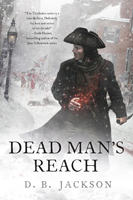 Well, I’ve been known to sign the wrong name in the occasional book, but other than that, not really. The two series have certain things in common both protagonists are conjuring investigators, the books in both series are standalones loosely linked by my character arcs, and both rely on certain urban fantasy tropes: the ghostly spirit guide, the noir voice, the powerfully ambient setting.
Well, I’ve been known to sign the wrong name in the occasional book, but other than that, not really. The two series have certain things in common both protagonists are conjuring investigators, the books in both series are standalones loosely linked by my character arcs, and both rely on certain urban fantasy tropes: the ghostly spirit guide, the noir voice, the powerfully ambient setting.
In other ways, though, the books are very different. In part because one is historical and the other is contemporary, the narrative voices are quite distinct. And from a writing perspective, each story presents unique challenges. So it turns out that when I’m writing as D.B. Jackson, I feel very much immersed in that world, and the same is true when I’m writing under my own name. Plus, shifting between the two keeps my writing fresh.
Urban fantasy is sometimes thought of as a subgenre dominated by female authors writing female protagonists, and yet here you are writing two series in the genre, both featuring male heroes. Why go that route?
I was aware of the dynamic. There are a few prominent examples of men writing about men in the field Jim Butcher’s Harry Dresden books, of course; Kevin Hearne’s Iron Mage series; Richard Kadrey’s Sandman Slim novels. But they do seem to be the exceptions, and I can name so many female authors doing terrific work in urban fantasy: Kim Harrison, Laurel K. Hamilton, Patricia Briggs, Faith Hunter, C.E. Murphy, Kat Richardson, and many more.
One of the reasons I chose the D.B. Jackson pseudonym when I first started writing UF, was that I wanted to use a genderneutral pen name. It used to be that women in fantasy and SF had to “disguise themselves” by camouflaging their names as I have. Today, in a welcome turnabout, it’s us guys who have to do that, at least in this subgenre.
But I also think that there is room in urban fantasy for all of us, male and female. I try to draw my heroes as honestly as I can. I make them wellrounded. They have a dark side, they have a sensitive side. They can act like typical guys, but they can also be tender, loving, vulnerable. In short, they’re not “male characters” so much as they’re people. And I surround them with strong female characters colleagues, rivals, love interests who are realistic and balanced as well.
Tell us a bit more about that. You are writing in two distinctly different time periods, the colonial era and the present day. Do you find that you need to treat your female characters in the two projects differently in order to make the books realistic?
Without trying to be glib, the answer is both yes and no. Yes, in that I make ALL my characters a bit different in the Thieftaker books. They speak differently, they have different sensibilities, their dayto-day concerns are not the same as ours. In order for those books to ring true, I have my characters speak in something that approximates an 18th century lexicon (while still making their dialog decipherable for a modern audience), and I make them behave and dress in ways that are appropriate to their time. So, for instance, my female characters all wear dresses. (Except for Sephira Pryce, Ethan Kaille’s rival in thieftaking, who wears breeches and a waistcoat, as would a man working in the streets. I’ll get to Sephira in a moment, because she is a special case.) In the same way, I do not have women in positions of political power, because there were no women in such offices in the 1760s.
But in other ways, the women in the Thieftaker books are every bit as strong and independent as women in the Fearsson books, and this comes as something of a surprise to some people. The fact is though (putting on my hat as history Ph.D.) the strict circumscribing of women’s societal roles, something we generally associate loosely with “the past,” was a nineteenth and early twentieth century phenomenon. Women in the eighteenth century had far more freedom, socially, sexually, economically, than their counterparts a century later. And so having Kannice Lester, a young widow who is Ethan’s love interest, own and run a tavern is perfectly legitimate historically. Janna Windcatcher, another tavern owner, is also black and free, which makes her somewhat unusual, but my no means anachronistic in pre-Revolutionary Boston.
The most unusual character is Sephira, who as a thieftaker and, essentially, a criminal, steps farthest from any examples I have found in the historical record. Honestly, I’m fine with that. Yes, I took a liberty with her, but she is such a fun character I really don’t care.
Having Ethan’s rival be a woman brilliant, ruthless, kickass, beautiful, overtly sexual infuses their interactions with a crackling energy, and gives incredible power to all of my plot lines.
The one thing I did in the Fearsson books that I didn’t do in the Thieftaker series was have openly gay characters of either gender. In The Case Files of Justis Fearsson, Jay’s closest friend and former partner on the police force is Kona Shaw, an African-American woman involved with Margarite Santos, a lawyer in the D.A.’s office. The reason I don’t have openly gay characters in the Thieftaker novels is that I didn’t know how to address the issue in a historically accurate way. Reliable records on the position of gays in colonial society are pretty hard to come by.
In every other way, though, the distance between the female characters in the Thieftaker books and those in the Fearsson books is far less than some might expect.
What’s up next for you after this summer’s releases?
 There’s still one more Fearsson book in the pipeline: SHADOW’S BLADE will be out next May. And I have been collaborating with Faith Hunter, author of the New York Times bestselling Jane Yellowrock books on a crossover project that combines her universe with the Thieftaker world. We released a novelette earlier this summer and we’d both like to write more in that mashup world.
There’s still one more Fearsson book in the pipeline: SHADOW’S BLADE will be out next May. And I have been collaborating with Faith Hunter, author of the New York Times bestselling Jane Yellowrock books on a crossover project that combines her universe with the Thieftaker world. We released a novelette earlier this summer and we’d both like to write more in that mashup world.
But aside from that, I’m not sure yet. I have an idea for a new epic fantasy, but it still needs a lot of prep work before I’ll be ready to write it. So I suppose I’ll be diving into that when the summer’s over.
_______________________________
As you can imagine, twice the number of pen names means there’s a whole lot of David B. Coe to be had on the Internet! As David B. Coe, he’s got a website, blog, Facebook page and Twitter feed, as well as an Amazon author page. Then as D.B. Jackson, he’s also got a whole other separate website. Enjoy!
Tina Connolly versus The Heroine Question
 Tina Connolly is the author of the Ironskin
Tina Connolly is the author of the Ironskin trilogy from Tor Books, and the Seriously Wicked
series, from Tor Teen. Ironskin, her first fantasy novel, was a Nebula finalist. Her stories have appeared in Women Destroy SF, Lightspeed, Tor.com, Strange Horizons, Beneath Ceaseless Skies, and many more. Her narrations have appeared in audiobooks and podcasts including Podcastle, Beneath Ceaseless Skies, John Joseph Adams’The End is Nigh series, and more. She runs the Parsec-winning flash fiction podcast Toasted Cake.
Is there a literary heroine on whom you imprinted as a child? A first love, a person you wanted to become as an adult, a heroic girl or woman you pretended to be on the playground at recess?
Oh, totally. Some of my favorites: Aerin of Robin McKinley’s The Hero and the Crown, Anne and Emily from L.M. Montgomery’s books, several of the theatre-loving girls in Noel Streatfeild’s series (particularly Sorrel from Theatre Shoes), and Menolly in Anne McCaffrey’s Harper Hall trilogy.
What it was they did or what qualities did they embody that captured your imagination?
Sometimes they knew what they wanted, and sometimes it was more an inchoate yearning to do something. Stubborn. Anne having to deal with floods of emotion when struck by beauty (what is it, how do you transmute it into something). But despite being a lovely person, she didn’t particularly do anything with her creativity, not lasting, anyway, which made me end up identifying more with Emily, even though I didn’t want to be a writer as a child. The artistic heroines of Streatfeild’s books learn that you have to work at your craft, which was always a valuable lesson.
Aerin has to deal with a wild sort of magic running through her, and figure out how to make it useful, to help her country. (Not to mention the stubbornness of going through the scientific process, trying a billion different tweaks to her fireproof ointment till one works.) Menolly has to make music, and when she can’t, she runs away, not so much out of a well-thought out plan, just that the urge to create drives you on.
How do these women compare to the female characters in your work? Are they your heroines’ literary ancestors?
That is a really interesting question, because I don’t think I’ve written a heroine (in my books, at least) driven by the creative process yet (though I keep saying I want to write one.) All my heroines are stubborn, yeah. I was thinking it through and so far all my book heroines are driven by the urge to help, to set something right. There is something that they identify with, something that makes it personal.
In my newest book, Seriously Wicked, heroine Cam is stuck living with a *seriously wicked* witch.
When the witch summons a demon, he accidentally gets into the new cute boy at school. So Cam is determined to help the boy in distress, since it’s a little bit her fault, and even more it’s just flat-out empathy for someone else getting roped into the same awful things she’s roped into every day. So she’s stubborn, like me, and like my favorite heroines. I was realizing the other day that another trait we share is that Cam is certain she can juggle it all, keep all the balls and plates spinning. Stop the witch’s schemes and still get an A in Algebra.
I do want to write a creative-process-driven heroine, though. I just need to find the right SF-nal setting for it….
_______
Tina Connolly’s website is here, and you can find her on Twitter and on Facebook.
_______
About this post: The Heroine Question is my name for a series of short interviews with female writers about their favorite characters and literary influences. Clicking the link will take you to all the other interviews, with awesome people like Jane Lindskold, Gemma Files, Caitlin Sweet, and Jessica Reisman.






